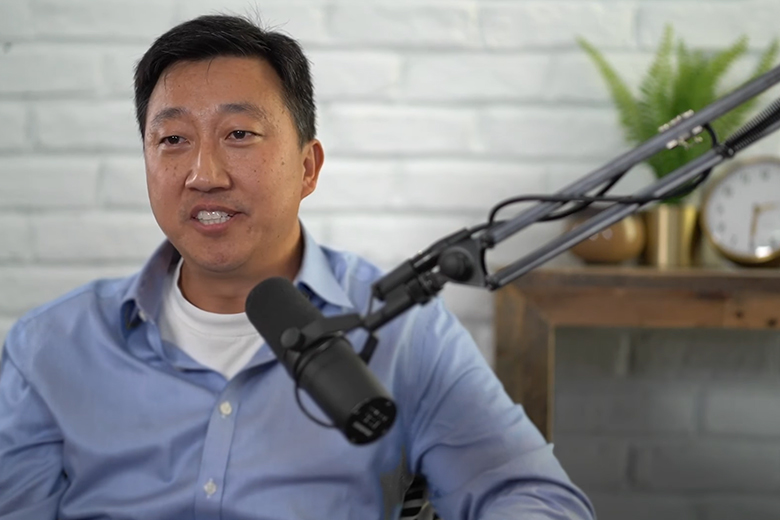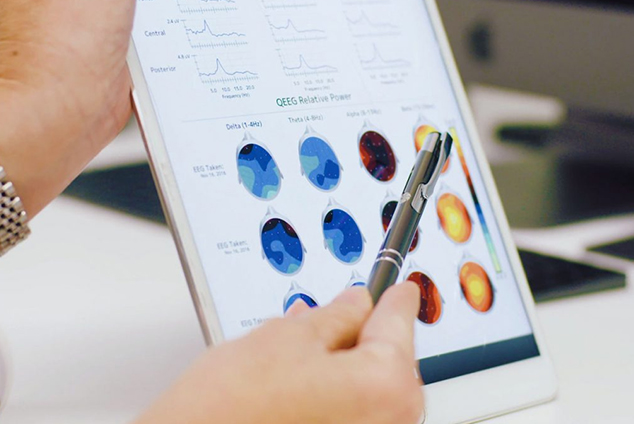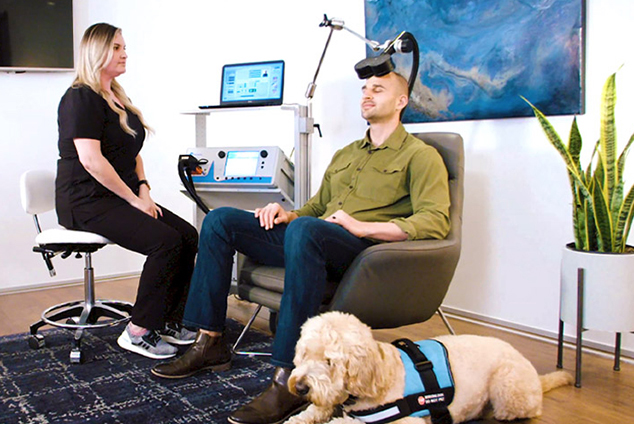MeRT Treatment for Post-Traumatic Stress Disorder

PTSD, or Post-Traumatic Stress Disorder, can occur when a person has experienced or witnessed terrifying life events. It can also be triggered when someone has gone through extended periods of severe stress.
Some people who experience extreme trauma can bounce back eventually. However, for others, the symptoms of PTSD can continue for months or years and sometimes can get worse. Additionally, it’s possible to have a delayed onset of Post-Traumatic Stress, as in some cases of child abuse, for example. Others may get through other types of traumatic events, only to have them triggered years later by something else.
One study completed by the National Institute of Health indicates that during the past year, up to 3.6% of adults experienced PTSD. The symptoms associated with this mental health problem can significantly affect the quality of life, relationships, and the ability to cope with everyday, common stressors.
Simply put, we use a magnetic field guided by sophisticated imaging and diagnostics to balance brain function. This technology has been used to help hundreds of veterans experiencing PTSD. Defense One published an article detailing how veterans are benefitting from MeRT in the article, “Zap: How Electric Therapy is Curing Navy Seals of PTSD.“
Many people who experience post-traumatic stress also suffer from other mental health conditions, such as depression and anxiety. The qEEG imaging will identify all areas of dysregulation in the brain, and the MeRT treatment will address those as well.
Currently, the neuromodulation equipment used is FDA-cleared for Depression and OCD (Obsessive-compulsive disorder). However, studies are underway through Texas A&M University in order to seek FDA clearance for PTSD and Traumatic Brain Injury. Currently, the treatment is considered “off-label” for other conditions.
MeRT as a PTSD Treatment
The MeRT treatment process utilizes TMS (transcranial magnetic stimulation). However, it is a much more individualized approach than TMS. TMS has been used for a long time to treat dysregulation within the brain. However, in and of itself, it is more of a one-size-fits-all approach to treatment since it is only able to target a single location in the brain with a single frequency, regardless of condition.
MeRT is a unique and much-improved process of utilizing TMS. Using a quantitative EEG/EKG to determine exactly what part of the brain is affected and to what degree, we can tailor treatment specifically to each individual’s needs. Read more about MeRT.
Causes of PTSD

- Experiencing or witnessing an extreme or lasting traumatic event
- Careers such as being in the military or being a first responder
- Substance abuse
- Combat exposure
- Sexual or physical assault
- Child abuse
- Spousal abuse
- Traumatic events such as car accidents, plane crashes, fires, or natural disasters
- Having little to no support system of family or friends
Symptoms of PTSD
PTSD, or Post-Traumatic Stress Disorder, can occur when a person has experienced or witnessed terrifying life events. It can also be triggered when someone has gone through extended periods of severe stress.
Symptoms can vary from person to person since each individual can handle major stressors a little differently, but these are some of the common things that people can experience:
- Flashbacks to the event(s)
- Depression
- Insomnia
- Repeated nightmares
- Anxiety and/or panic attacks
- Severe mood swings
- Anger and rage
- Being startled easily.
- Avoidance of places or people that remind you of the trauma
- Memory problems
- Concentration and focus problems
- Numb feelings
- Self-destructive behavior
- Hypersensitivity to sounds
- Emotional and/or physical reactions to noises
- Suicidal thoughts
- Negative outlook
MeRT for PTSD Treatment featured on the “Broken Brain” Podcast by Dr. Mark Hyman
Dr. Mark Hyman is an esteemed functional medicine physician and best-selling author. He founded the Cleveland Clinic Functional Medicine clinic and oversees the famous podcast called “The Broken Brain.” One episode featured MeRT for the treatment of PTSD, Traumatic Brain Injuries, and Concussions. They also discuss major depressive disorder (MDD) and suicidal tendencies.
Dr. Erik Won from the Brain Treatment Center here in California spoke extensively about the MeRT technology. He discussed MeRT’s use to treat veterans who have suffered these conditions after coming back from war. He also shared many treatment successes.

How MeRT Can Help PTSD
The patient first undergoes a qEEG (quantitative EEG) to identify dysregulation occurring in the brain. The results will show the brain’s brainwave pattern and function. This detailed analysis allows our doctors to determine the exact neural synchronization protocol for each patient. The objective is to encourage improved communication within the brain, which can lead to significant clinical improvements. *
TMS (transcranial magnetic stimulation) is a method of treating PTSD. TMS modulates the brain’s activity by using magnetic fields that pass through the scalp from an electromagnetic coil. However, TMS is more of a one-size-fits-all approach because it only targets a single location in the brain with a single frequency.
MeRT utilizes TMS. However, it is greatly improved since we individualize treatment for each patient’s condition and needs based on the qEEG results. We customize the frequency, location, and power used for each individual.
MeRT is a more evolved version of TMS since its protocol combines technologies of transcranial magnetic stimulation, quantitative electroencephalogram (qEEG), and electrocardiogram (ECG/EKG). This combination allows for a treatment protocol based on each person’s unique brain pattern.
MeRT for PTSD is usually 4-8 weeks long. Since it is a type of therapy, appointments are every day, Monday through Friday, and usually last approximately 30 minutes.
Most often, the patient will begin to notice improvements in the way they feel during the first week. After going through treatment, there is not usually a need for any follow-up treatment for PTSD unless the patient experiences additional trauma.

The EEG report shows areas of the brain that are not functioning or connecting to other parts of the brain. We can then address these areas with tailored TMS.

A trained neuro-technician delivers TMS as part of the MeRT treatment protocol.
What to Expect
Initially, we will schedule two appointments for new patients. During the first appointment, our neuro-technician will perform a qEEG/EKG. This is a painless procedure. All you need to do is sit in a chair with your eyes closed until we complete the test. This ensures we gather enough data to compose an accurate reading.
Your second appointment will serve as your clinical evaluation from the doctor. He will have your test results and can go over treatment protocols, along with answering any questions you may have.
If you are uncertain whether MeRT is the right treatment for you, the testing and consultation will allow both you and the doctor to decide if you may benefit from Magnetic Resonance Therapy.
Assessment Period
Should you decide to proceed with treatment, we will schedule you for your two-week assessment of treatment. The assessment period includes daily treatment Monday through Friday for the first week and Monday through Thursday for the second week.
During this two-week assessment, we are looking for any clinical changes and that you are having a positive response to the treatment. You (or your child) will likely notice some improvements starting to take place. On the second Friday of the assessment, we will perform another qEEG/EKG to confirm that changes are also showing in the brain.
Daily treatment consists of sitting in a chair while the neuro-technician administers treatment from a hand-held magnet held on the scalp. This is a painless and non-invasive treatment. We administer magnetic impulses every 6-8 seconds each minute for about 30 minutes. You may feel a slight sensation while we administer treatment, but it is not uncomfortable or painful.
After going through the two-week assessment period, we usually continue MeRT for an additional 4-6 weeks (for a total of 6-8 weeks). There are cases where treatment duration may wish to be extended or where patients may want to return at a later time for a follow-up treatment session of a week or so, but this isn’t mandatory. Each individual is different, and protocols may vary.
During your total treatment duration, you will have interim EEGs every two weeks and at the end of your treatment to monitor your progress. Once treatment is over, you and the doctor can make the determination if further duration of treatment or follow-up is needed based on your progress.